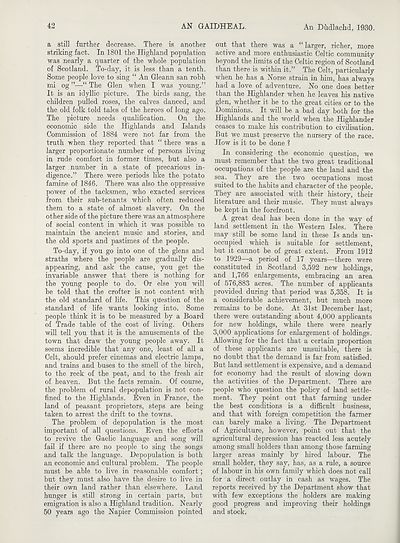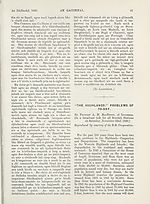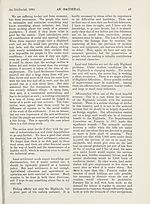An Comunn Gàidhealach Publications > Gaidheal > Volume 26, October 1930--September 1931
(62) Page 42
Download files
Complete book:
Individual page:
Thumbnail gallery: Grid view | List view

42
AN GAIDHEAL.
An Dfidlachd, 1930.
a still further decrease. There is another
striking fact. In 1801 the Highland population
was nearly a quarter of the whole population
of Scotland. To-day, it is less than a tenth.
Some people love to sing “ An Gleann san robh
mi og ”—“ The Glen when I was young.”
It is an idyllic picture. The birds sang, the
children pulled roses, the calves danced, and
the old folk told tales of the heroes of long ago.
The picture needs qualification. On the
economic side the Highlands and Islands
Commission of 1884 were not far from the
truth when they reported that “ there was a
larger proportionate number of persons living
in rude comfort in former times, but also a
larger number in a state of precarious in¬
digence.” There were periods like the potato
famine of 1846. There was also the oppressive
power of the tacksmen, who exacted services
from their sub-tenants which often reduced
them to a state of almost slavery. On the
other side of the picture there was an atmosphere
of social content in which it was possible to
maintain the ancient music and stories, and
the old sports and pastimes of the people.
To-day, if you go into one of the glens and
straths where the people are gradually dis¬
appearing, and ask the cause, you get the
invariable answer that there is nothing for
the young people to do. Or else you will
be told that the crofter is not content with
the old standard of life. This question of the
standard of life wants looking into. Some
people think it is to be measured by a Board
of Trade table of the cost of living. Others
will tell you that it is the amusements of the
town that draw the young people away. It
seems incredible that any one, least of all a
Celt, should prefer cinemas and electric lamps,
and trains and buses to the smell of the birch,
to the reek of the peat, and to the fresh air
of heaven. But the facts remain. Of course,
the problem of rural depopulation is not con¬
fined to the Highlands. Even in France, the
land of peasant proprietors, steps are being
taken to arrest the drift to the towns.
The problem of depopulation is the most
important of all questions. Even the efforts
to revive the Gaelic language and song will
fail if there are no people to sing the songs
and talk the language. Depopulation is both
an economic and cultural problem. The people
must be able to live in reasonable comfort;
but they must also have the desire to live in
their own land rather than elsewhere. Land
hunger is still strong in certain parts, but
emigration is also a Highland tradition. Nearly
50 years ago the Napier Commission pointed
out that there was a “ larger, richer, more
active and more enthusiastic Celtic community
beyond the limits of the Celtic region of Scotland
than there is within it.” The Celt, particularly
when he has a Norse strain in him, has always
had a love of adventure. No one does better
than the Highlander when he leaves his native
glen, whether it be to the great cities or to the
Dominions. It will be a bad day both for the
Highlands and the world when the Highlander
ceases to make his contribution to civilisation.
But we must preserve the nursery of the race.
How is it to be done ?
In considering the economic question, we
must remember that the two great traditional
occupations of the people are the land and the
sea. They are the two occupations most
suited to the habits and character of the people.
They are associated with their history, their
literature and their music. They must always
be kept in the forefront.
A great deal has been done in the way of
land settlement in the Western Isles. There
may still be some land in these Is ands un¬
occupied which is suitable for settlement,
but it cannot be of great extent. From 1912
to 1929—a period of 17 years—there were
constituted in Scotland 3,592 new holdings,
and 1,766 enlargements, embracing an area
of 576,883 acres. The number of applicants
provided during that period was 5,358. It is
a considerable achievement, but much more
remains to be done. At 31st December last,
there were outstanding about 4,000 applicants
for new holdings, while there were nearly
3,000 applications for enlargement of holdings.
Allowing for the fact that a certain proportion
of these applicants are unsuitable, there is
no doubt that the demand is far from satisfied.
But land settlement is expensive, and a demand
for economy had the result of slowing down
the activities of the Department. There are
people who question the policy of land settle¬
ment. They point out that farming under
the best conditions is a difficult business,
and that with foreign competition the farmer
can barely make a living. The Department
of Agriculture, however, point out that the
agricultural depression has reacted less acutely
among small holders than among those farming
larger areas mainly by hired labour. The
small holder, they say, has, as a rule, a source
of labour in his own family which does not call
for a direct outlay in cash as wages. The
reports received by the Department show that
with few exceptions the holders are making
good progress and improving their holdings
and stock,
AN GAIDHEAL.
An Dfidlachd, 1930.
a still further decrease. There is another
striking fact. In 1801 the Highland population
was nearly a quarter of the whole population
of Scotland. To-day, it is less than a tenth.
Some people love to sing “ An Gleann san robh
mi og ”—“ The Glen when I was young.”
It is an idyllic picture. The birds sang, the
children pulled roses, the calves danced, and
the old folk told tales of the heroes of long ago.
The picture needs qualification. On the
economic side the Highlands and Islands
Commission of 1884 were not far from the
truth when they reported that “ there was a
larger proportionate number of persons living
in rude comfort in former times, but also a
larger number in a state of precarious in¬
digence.” There were periods like the potato
famine of 1846. There was also the oppressive
power of the tacksmen, who exacted services
from their sub-tenants which often reduced
them to a state of almost slavery. On the
other side of the picture there was an atmosphere
of social content in which it was possible to
maintain the ancient music and stories, and
the old sports and pastimes of the people.
To-day, if you go into one of the glens and
straths where the people are gradually dis¬
appearing, and ask the cause, you get the
invariable answer that there is nothing for
the young people to do. Or else you will
be told that the crofter is not content with
the old standard of life. This question of the
standard of life wants looking into. Some
people think it is to be measured by a Board
of Trade table of the cost of living. Others
will tell you that it is the amusements of the
town that draw the young people away. It
seems incredible that any one, least of all a
Celt, should prefer cinemas and electric lamps,
and trains and buses to the smell of the birch,
to the reek of the peat, and to the fresh air
of heaven. But the facts remain. Of course,
the problem of rural depopulation is not con¬
fined to the Highlands. Even in France, the
land of peasant proprietors, steps are being
taken to arrest the drift to the towns.
The problem of depopulation is the most
important of all questions. Even the efforts
to revive the Gaelic language and song will
fail if there are no people to sing the songs
and talk the language. Depopulation is both
an economic and cultural problem. The people
must be able to live in reasonable comfort;
but they must also have the desire to live in
their own land rather than elsewhere. Land
hunger is still strong in certain parts, but
emigration is also a Highland tradition. Nearly
50 years ago the Napier Commission pointed
out that there was a “ larger, richer, more
active and more enthusiastic Celtic community
beyond the limits of the Celtic region of Scotland
than there is within it.” The Celt, particularly
when he has a Norse strain in him, has always
had a love of adventure. No one does better
than the Highlander when he leaves his native
glen, whether it be to the great cities or to the
Dominions. It will be a bad day both for the
Highlands and the world when the Highlander
ceases to make his contribution to civilisation.
But we must preserve the nursery of the race.
How is it to be done ?
In considering the economic question, we
must remember that the two great traditional
occupations of the people are the land and the
sea. They are the two occupations most
suited to the habits and character of the people.
They are associated with their history, their
literature and their music. They must always
be kept in the forefront.
A great deal has been done in the way of
land settlement in the Western Isles. There
may still be some land in these Is ands un¬
occupied which is suitable for settlement,
but it cannot be of great extent. From 1912
to 1929—a period of 17 years—there were
constituted in Scotland 3,592 new holdings,
and 1,766 enlargements, embracing an area
of 576,883 acres. The number of applicants
provided during that period was 5,358. It is
a considerable achievement, but much more
remains to be done. At 31st December last,
there were outstanding about 4,000 applicants
for new holdings, while there were nearly
3,000 applications for enlargement of holdings.
Allowing for the fact that a certain proportion
of these applicants are unsuitable, there is
no doubt that the demand is far from satisfied.
But land settlement is expensive, and a demand
for economy had the result of slowing down
the activities of the Department. There are
people who question the policy of land settle¬
ment. They point out that farming under
the best conditions is a difficult business,
and that with foreign competition the farmer
can barely make a living. The Department
of Agriculture, however, point out that the
agricultural depression has reacted less acutely
among small holders than among those farming
larger areas mainly by hired labour. The
small holder, they say, has, as a rule, a source
of labour in his own family which does not call
for a direct outlay in cash as wages. The
reports received by the Department show that
with few exceptions the holders are making
good progress and improving their holdings
and stock,
Set display mode to:
![]() Universal Viewer |
Universal Viewer | ![]() Mirador |
Large image | Transcription
Mirador |
Large image | Transcription
| An Comunn Gàidhealach > An Comunn Gàidhealach Publications > Gaidheal > Volume 26, October 1930--September 1931 > (62) Page 42 |
|---|
| Permanent URL | https://digital.nls.uk/125153148 |
|---|
| Description | This contains items published by An Comunn, which are not specifically Mòd-related. It includes journals, annual reports and corporate documents, policy statements, educational resources and published plays and literature. It is arranged alphabetically by title. |
|---|
| Description | A collection of over 400 items published by An Comunn Gàidhealach, the organisation which promotes Gaelic language and culture and organises the Royal National Mòd. Dating from 1891 up to the present day, the collection includes journals and newspapers, annual reports, educational materials, national Mòd programmes, published Mòd literature and music. |
|---|---|
| Additional NLS resources: |
|

